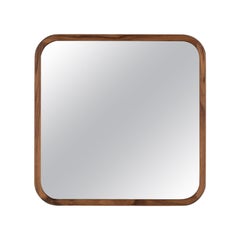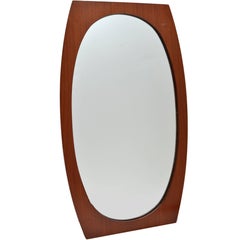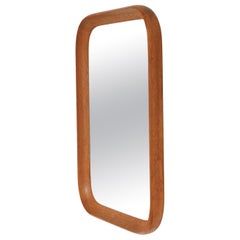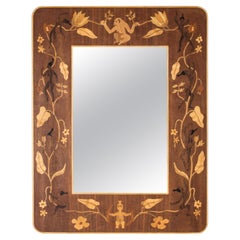Walnut Wall Mirrors
2
2
to
3
1
4
2
3
200
64
28
24
23
19
19
10
8
7
7
6
6
4
3
1
2
2
2
1
1
Height
to
Width
to
38,087
287
191
164
132
3
2
1
1
1
1
1
Style: Scandinavian Modern
Material: Walnut
Eriksmåla Glas, Freeform Wall Mirror, Walnut, Sweden, 1950s
Located in High Point, NC
A stained walnut freeform mirror designed and produced by Eriksmåla Glas, Sweden, c. 1950s.
Category
1950s Swedish Scandinavian Modern Vintage Walnut Wall Mirrors
Materials
Walnut
Silas Wall Mirror
Located in Los Angeles, CA
The Silas Wall Mirror and its elegant round shape plays with geometry, clean lines and form creating a strong visual statement in any room.
Standard sizes available in 36", 42" and...
Category
21st Century and Contemporary American Scandinavian Modern Walnut Wall Mirrors
Materials
Mirror, Ash, Oak, Walnut
Square Silhouette Mirror, Walnut Oil treated by OEO Studio for Fredericia
By OEO Studio
Located in Dubai, AE
Silhouette is a mirror framed in solid wood : Walnut oil treated, informed by a focus on materials, craftsmanship and the experience of living with design. The concept is based on a ...
Category
21st Century and Contemporary Latvian Scandinavian Modern Walnut Wall Mirrors
Materials
Walnut
Oval Scandinavian Modern Handmade Walnut Wall Mirror
Located in Miami, FL
Scandinavian Modern Elliptical mirror set in a complementary walnut wood frame.
Mid-Century Modern Craftsmanship made in Denmark.
Can be hung securely only vertical.
Good vintage con...
Category
1960s Danish Scandinavian Modern Vintage Walnut Wall Mirrors
Materials
Walnut, Mirror
Related Items
Scandinavian Modern Wall Mirror in Solid Oakwood, Denmark, 1950s
Located in Odense, DK
Wall mirror by a Danish cabinetmaker in the 1950s. The mirror is made of solid oakwood and is simple yet beautifully sculpted with brilliant joinery technique. In the style of Hans J...
Category
1950s Scandinavian Modern Vintage Walnut Wall Mirrors
Materials
Mirror, Oak
Italian Modern Wall Mirror Oval Teak Frame, 1950s
Located in Los Angeles, CA
Oval large teak frame, with oval mirrored glass.
The wood frame has different thickness in the apical width;
Is beautiful both in the vertical or horizontal version.
Category
1950s Italian Mid-Century Modern Vintage Walnut Wall Mirrors
Materials
Mirror, Wood
Svenskt Tenn Organic Wall Mirror, Rattan / Wicker, Bamboo, Sweden, 1950s
By Svenskt Tenn
Located in Stockholm, SE
A Large wall mirror retailed by Svenskt Tenn the iconic Swedish firm founded by Estrid Ericson and creatively led by Josef Frank. In finely braided wicker / rattan / cane and bamboo....
Category
1950s Swedish Scandinavian Modern Vintage Walnut Wall Mirrors
Materials
Bamboo, Wicker, Cane, Rattan, Mirror
H 29.14 in W 18.9 in D 0.79 in
Italian mid-century modern oval wall mirror, 1950s
Located in MIlano, IT
Italian mid-century modern oval wall mirror, 1950s
Oval shaped wall mirror. It has a decorative slant along the entire circumference. The support base is made of wood and supports an...
Category
1950s Italian Mid-Century Modern Vintage Walnut Wall Mirrors
Materials
Brass
Glas & Trä Wall Mirror Rosewood & Painted Wood Hovmantorp, Sweden 1950's
Located in New York, NY
A rosewood, black-painted wood and glass wall mirror designed and produced by Glas & Trä, Hovmantorp, Sweden, 1950s.
Some loss, requires restoration to improve condition.
Category
1950s Swedish Mid-Century Modern Vintage Walnut Wall Mirrors
Materials
Mirror, Rosewood, Paint
Tan Leather Modern Oval Fairmount Wall Mirror
By Lostine
Located in Philadelphia, PA
The fairmount wide oval mirror is a hand-stitched leather mirror with a frame made from natural vegetable tanned leather which will vary in color and darken slightly with age. The mirror sits inside the frame like a pocket. It comes with an iron hand hammered screw post...
Category
2010s American Modern Walnut Wall Mirrors
Materials
Leather, Mirror
Midcentury Sculptural Round Brass Wall Mirror, Sweden 1950s
Located in NUEMBRECHT, NRW
This beautiful brass loop wall mirror was designed and manufactured in Sweden in the 1950s. The brass frame with nice warm vintage patina. The mirror flawless.
Measures: Diameter a...
Category
1950s Swedish Mid-Century Modern Vintage Walnut Wall Mirrors
Materials
Brass
Vintage Wooden Mirror, Belgium Framed Wall Mirror Rectangular Wall Mirror
Located in Bastogne, BE
Very beautiful wall mirror in wooden carved frame, Belgium.
Fine gold gilt on wood hand-carved wall mirror frame with a hand-carved bouquet of flower...
Category
20th Century Belgian Walnut Wall Mirrors
Materials
Mirror, Wood
H 20.08 in W 12.6 in D 1.19 in
Vintage Studio Craft Asymmetrical Mirror, Walnut, 1970s
Located in Round Rock, TX
A whimsical, hand sculpted organic modern wall mirror. Made from beautiful old growth walnut with rich color and patina. Signed 'Reznik".
It measures 12.5" at its widest point, and ...
Category
1970s American Organic Modern Vintage Walnut Wall Mirrors
Materials
Mirror, Walnut
Midcentury Sculptural Round Brass Wall Mirror, Sweden, 1950s
Located in NUEMBRECHT, NRW
This beautiful brass loop wall mirror was designed and manufactured in Sweden in the 1950s. The brass frame with nice warm vintage patina. The mirror glass somehow cloudy due to age....
Category
1950s Swedish Mid-Century Modern Vintage Walnut Wall Mirrors
Materials
Brass
Pink Mirror by Studio Glustin
Located in Saint-Ouen (PARIS), FR
Splendid rectangular mirror with frame in brass and pink tainted glass.
Creation by Studio Glustin.
Category
2010s Italian Mid-Century Modern Walnut Wall Mirrors
Materials
Brass
Original Vintage Large Mid-Century Scandinavian Modern Wooden Wall Mirror, 1950s
Located in Warszawa, Mazowieckie
This tall wall mirror was made in Denmark during the 1950s. The rectangular mirror frame with flowing edges is made of solid wood in a dark shade of ...
Category
1950s Danish Scandinavian Modern Vintage Walnut Wall Mirrors
Materials
Mirror, Wood
H 42.13 in W 14.57 in D 0.79 in
Previously Available Items
Large Sculptural Swedish Modern Mirror, Sweden, 1940s
Located in Stockholm, SE
Large sculptural wall mirror produced in Sweden during the 1940s. The mirror frame is stained walnut wood and made with curvy sculptural lines. Very good vintage condition with no sc...
Category
1940s Swedish Scandinavian Modern Vintage Walnut Wall Mirrors
Materials
Mirror, Walnut
Mirror "Adoration" by G Gewall for Bohus Intarsia, Sweden, 1940s
By G. Gewall 1
Located in Stockholm, SE
Beautiful wooden mirror from Bohus Intarsia with a motif called “Adoration”. Inlays of contrasting wood depict flowers and leaves, interlacing with women, a monkey and a whimsical ch...
Category
1950s Swedish Scandinavian Modern Vintage Walnut Wall Mirrors
Materials
Mirror, Birch, Walnut, Glass
Erik Chambert Walnut Mirror, Swedish Modern, 1930s
Located in Skanninge, SE
Unusual mirror by Erik Chambert for Chamberts Möbelfabrik in Norrköping.
Really good quality and perfect condition.
Erik Chambert (1902-1988) was one of the first interior designers to graduate from Högre Konstindustriella Skolan (now the University College of Arts, Crafts, and Design, Konstfack) in 1925. Before that, he had been awarded a silver medal for his apprentice piece in cabinet-making. He and his brother, the master cabinet-maker Otto, ran the family furniture-making business AB Chamberts Möbelfabrik in Norrköping, with Erik as the artistic director. The company had been founded in 1883 by their father, Axel Chambert.
As an interior designer, Erik Chambert’s first major assignment was for the Stockholm Exhibition in 1930, where he designed the functionalist interior for an apartment by the recently-appointed municipal architect of Norrköping, Kurt von Schmalensee. Gotthard Johansson expressed his opinion on Chambert’s participation in the daily paper Svenska Dagbladet: “where simplicity has not become indigent, nor functionalism dogmatic”. The senior curator for the Stockholm Exhibition, Gregor Paulsson, commented on the apartment in an appreciative letter to Erik Chambert: “As for my personal opinion, I would like to say unconditionally that I consider it to be the biggest success of the entire exhibition. It is in keeping with the spirit we wished to achieve.”
Erik Chambert designed practical, comfortable and timeless furniture in a functionalist style that gave a blond, sober impression. Helena Dahlbäck Lutteman has called the style “humane functionalism”. Study trips around Europe after his graduation acquainted Erik Chambert with the Bauhaus school and Art Concrete. He was influenced by contemporary trends but reformulated what he saw and experienced in his style. For the Stockholm Exhibition, he designed a folding recliner with light wood construction and red varnished armrests in steel. This was the only time he used this particular material that was fashionable during that period. Källemo AB in Värnamo began making replicas of the recliner and other classics by Erik Chambert in recent decades. One of these new recliners is currently standing in the library of Arkitektur- och designcentrum (earlier Arkitekturmuseet) in Stockholm. Erik Chambert believed that a piece of furniture should be functional and blend with the surroundings. A work desk with a reversible pine top, one side for work and the other for more festive occasions, with a shelf construction of wood slats underneath for paper and drawings, was shown at an exhibition in Zurich in 1949. Usually, his designs were only produced in one or very few copies. The chair “Poem” from 1953 is a rare exception.
The year before he died, Erik Chambert said, “Exhibitions have been my life.” As a furniture designer, he participated in numerous prestigious international exhibitions together with AB Chamberts Möbelfabrik: Chicago in 1933, the world fairs in Brussels and Paris in 1935 and 1937 respectively, the international crafts exhibition in Berlin in 1938 and the world exhibition in New York in 1939.
Erik Chambert gave vent to his visual creativity when he designed furniture. This is evident, for instance, in the rich marquetry he made to order or for exhibitions. He took a delight in creating entire pictures, not just patterns, in marquetry, depicting figures or cityscapes in different woods. He often combined these with shimmering mother of pearl and metals. In 1945, he designed the cabinet “The Scales of Life”, now in the Nationalmuseum collection. The marquetry inlayer was Manne Manning. The cabinet was based on an eponymously titled gouache from 1943.
As an interior designer, Erik Chambert was frequently commissioned for public spaces and private homes. Most assignments were from institutions and private companies in and around Norrköping, but his clients also included Haga Palace and the Tessin Palace, through the National Board of Public Buildings. In addition to suggesting furniture and textiles, he was involved in deciding the color schemes for walls, designing fabrics, sometimes for specific purposes, composing tapestries and a few larger curtains with appliqué work. In the book “Svenska Textilier 1890-1990” (Swedish Textiles 1890-1990), Anne-Marie Ericsson writes, “An interesting example is the furniture designer Erik Chambert, who allowed both his disciplines, as an artist and a designer, to merge in his rhythmically distinct patterns for textile prints.” Erik Chambert collaborated with Jobs Handtryck and Tabergs Yllefabrik, among others. A textile with stylized Norrköping scenes for the foyer walls of the municipal theatre in Norrköping and also the textile ”Skyttlarna” was recently revived and put into production by Stadsmuseet in Norrköping. The museum also has the Chambert company’s archives in its collection.
In the 1920s and 1930s, Erik Chambert made many exquisite watercolored sketches of furniture set in their imagined context in the furnishing of a room. As studies for cabinet embellishments, wall paintings, and wallpaper he painted grass and flowers. Towards the end of the 1930s, the gouaches developed and began to feature figurative elements and organic non-figurative billowing forms. In 1943, Erik Chambert made his debut at the Liljevalchs autumn exhibition. He was subsequently represented in several exhibitions at Liljevalchs. In the 1950s, Erik Chambert painted abstracts which he initially called Compositions, followed by a number of capital letters. Bo Sylvan writes that Erik Chambert’s paintings tended towards “geometrically pruned shapes and a fastidious palette”. Up until 1959, Erik Chambert painted in gouache, but in 1960 he went over to oils.
In the mid-1960s, Erik Chambert abandoned his flat compositions and began creating reliefs in white, black or red paper or silver paper and gold foil, in a striving to achieve tension with a spatial effect. The viewer was encouraged to move in front of the work to perceive how light and shade enhanced the impression. The reliefs were built into boxes of Plexiglas, which were part of the work of art. “Lady with Dog” is an early example of this technique. The work was produced in 100 identical copies. It was included in the art society Konstfrämjandet’s exhibition “Multikonst” (Multi-Art) which was shown at 100 venues throughout Sweden simultaneously in 1967.
Erik Chambert has been regarded as a Concretist but, as Staffan Carlén points out in the foreword to the catalog to the solo exhibition at Millesgården in 1990, “Erik Chambert did not want to label his works as Concrete, and it would therefore perhaps be more Apt to speak of geometric abstraction.” His works were nearly always based on an experience or impression, such as thoughts on life, as in “The Scales of Life”, the triptych “Life Cycle” from 1963, now in Norrköpings konstmuseum, or series I-X from “A Life” or other pictures from the same, often made in connection with annual summer trips to European destinations, for instance “Les Halles” (1965), “Pointe du Raz” (1967) or “Gibraltar” (1980).
In the late 1960s, throughout the 1970s and in the early 1980s, Erik Chambert pursued his exploration of light and refraction, using only Plexiglas sheets and rods, occasionally with additions of paint to enhance the motif. In his speech at the opening of the exhibition at Millesgården, Bo Sylvan called the crystal-clear Plexiglas relief sculptures from the early 1980s “light organs”. All the Plexiglas works with their accompanying boxes were sawn, honed and joined by hand with aesthetic ingenuity. As a young cabinetmaker’s apprentice, he had learned to handle wood with great skill. Likewise, the mature artist used his inventiveness and craftsmanship to find technical solutions when working with Plexiglas. All the boxes are square, the largest measuring 1×1 meter. Erik Chambert enjoyed the Challenge of achieving expansive tensions in a square.
Otto G. Carlsund and Gösta Adrian Nilsson...
Category
1930s Swedish Scandinavian Modern Vintage Walnut Wall Mirrors
Materials
Glass, Walnut
Mirror Swedish Grace, 1920s-1930s
Located in Skanninge, SE
Very nice and unusual Swedish mirror in birch, elm, and walnut.
Good original condition, unrestored.
Category
1920s European Scandinavian Modern Vintage Walnut Wall Mirrors
Materials
Glass, Birch, Elm, Walnut
Midcentury Swedish Modern Mirror, 1960s
Located in Stockholm, SE
Beautiful, large Swedish modern mirror. This mirror is a rectangular shape with rounded corners that have a sawtooth joined construction. Manufactured by AB Ateljé Glas...
Category
1960s Swedish Scandinavian Modern Vintage Walnut Wall Mirrors
Materials
Mirror, Walnut
Recently Viewed
View AllMore Ways To Browse
Antique Mirror 1930s
Retro Distressed Mirror
Large Matching Mirrors
French Riviera Bamboo
1940s Venetian Mirror
Round Wooden Mirror
Pair Louis Xvi Mirrors
Italian Arch Mirror
Gilted Wall Garland
Plaster Framed Mirror
Large Round Wood Mirror
Deco Etched Mirror
Modern Danish Wood Mirror
Venetian Mirror With Flowers
Brass Silver Wall Mirror
Gold Frame Leaves Mirror
Hollywood Regency Gilt Wood Mirror
Antique Solid Wood Mirror







